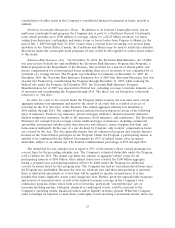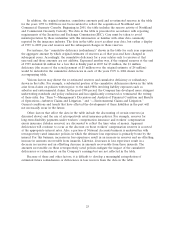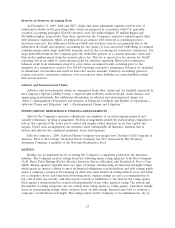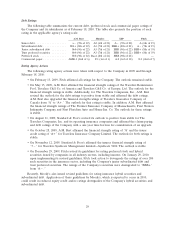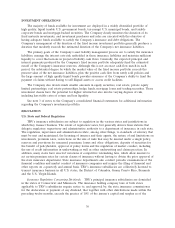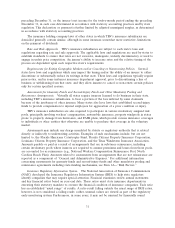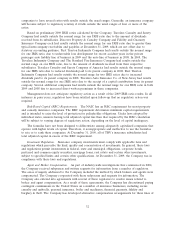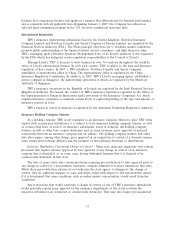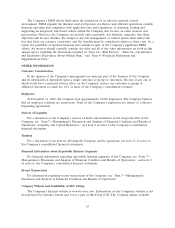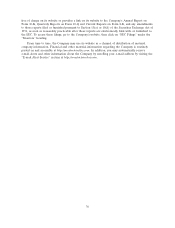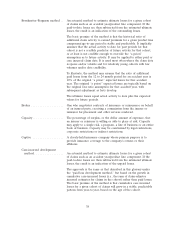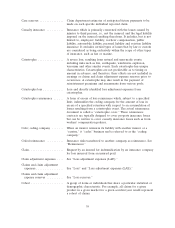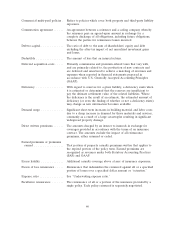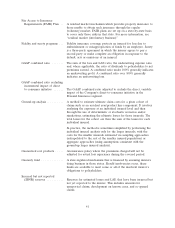Travelers 2009 Annual Report Download - page 44
Download and view the complete annual report
Please find page 44 of the 2009 Travelers annual report below. You can navigate through the pages in the report by either clicking on the pages listed below, or by using the keyword search tool below to find specific information within the annual report.companies to have several ratios with results outside the usual ranges. Generally, an insurance company
will become subject to regulatory scrutiny if it falls outside the usual ranges of four or more of the
ratios.
Based on preliminary 2009 IRIS ratios calculated by the Company, Travelers Casualty and Surety
Company had results outside the normal range for one IRIS ratio due to the amount of dividends
received from its subsidiaries. Discover Property & Casualty Company and Fidelity and Guaranty
Insurance Company each had results outside the normal range for one IRIS ratio due to greater than
typical intercompany receivables and payables at December 31, 2009, which are not offset due to
statutory accounting guidance. First Trenton Indemnity Company had results outside the normal range
for one IRIS ratio, due to unfavorable loss development for recent accident years in the private
passenger auto liability line of business in 2009 and the auto line of business in 2008. In 2008, The
Travelers Indemnity Company and The Standard Fire Insurance Company had results outside the
normal range on one IRIS ratio, due to the amount of dividends received from their respective
subsidiaries. Travelers Casualty and Surety Company of America had results outside the normal range
for one IRIS ratio due to reduced dividends paid to its parent company in 2008. First Trenton
Indemnity Company had results outside the normal range for two IRIS ratios due to increased
dividends paid to its parent company in 2008. Travelers Auto Insurance Co. of New Jersey had results
outside the normal range for one IRIS ratio due to the receipt of a capital contribution from its parent
company. Several additional companies had results outside the normal range for one IRIS ratio in both
2009 and 2008 due to increased direct written premiums in these companies.
Management does not anticipate regulatory action as a result of the 2009 IRIS ratio results. In all
instances in prior years, regulators have been satisfied upon follow-up that no regulatory action was
required.
Risk-Based Capital (RBC) Requirements. The NAIC has an RBC requirement for most property
and casualty insurance companies. The RBC requirement determines minimum capital requirements
and is intended to raise the level of protection for policyholder obligations. Under laws adopted by
individual states, insurers having total adjusted capital less than that required by the RBC calculation
will be subject to varying degrees of regulatory action, depending on the level of capital inadequacy.
The formulas have not been designed to differentiate among adequately capitalized companies that
operate with higher levels of capital. Therefore, it is inappropriate and ineffective to use the formulas
to rate or to rank these companies. At December 31, 2009, all of TRV’s insurance subsidiaries had
total adjusted capital in excess of the RBC requirement.
Investment Regulation. Insurance company investments must comply with applicable laws and
regulations which prescribe the kind, quality and concentration of investments. In general, these laws
and regulations permit investments in federal, state and municipal obligations, corporate bonds,
preferred and common equity securities, mortgage loans, real estate and certain other investments,
subject to specified limits and certain other qualifications. At December 31, 2009, the Company was in
compliance with these laws and regulations.
Agent and Broker Compensation. As part of industry-wide investigations that commenced in 2004,
the Company received subpoenas and written requests for information from a number of regulators.
The areas of inquiry addressed to the Company included the method by which brokers and agents were
compensated. The Company cooperated with these subpoenas and requests for information. The
Company also entered into agreements with several of these regulators to resolve issues related to
broker and agent compensation. As a result of these agreements, the Company has discontinued paying
contingent commissions in the United States on a number of insurance businesses, including excess
casualty and umbrella, personal insurance, boiler and machinery, financial guaranty, fidelity and
burglary & theft. The Company has developed alternative compensation arrangements for these lines of
32



